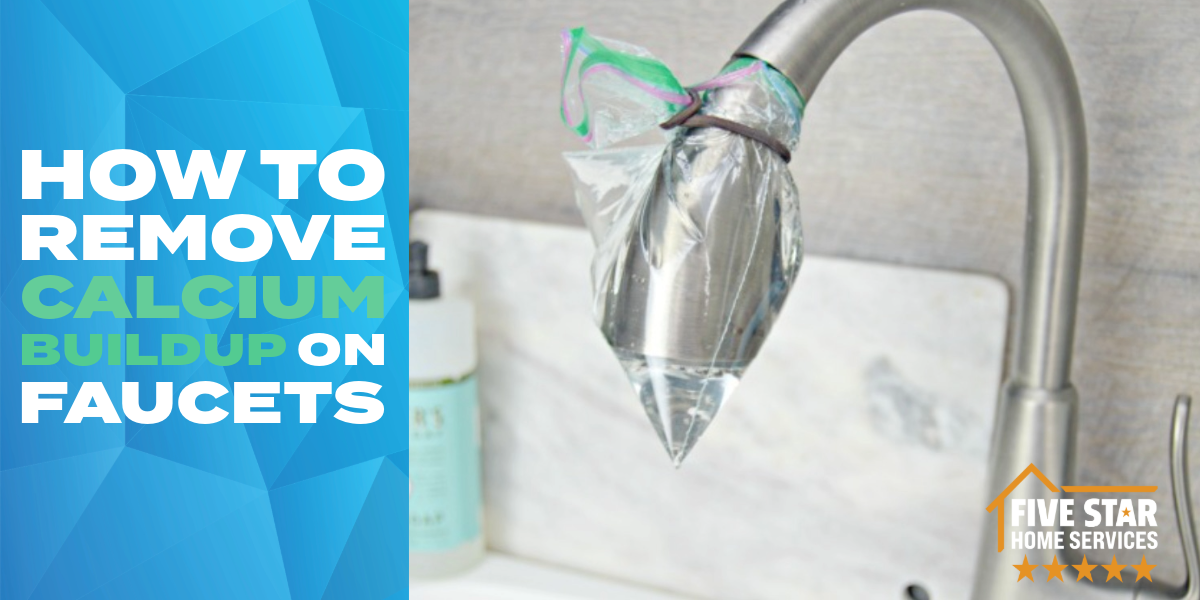Is your faucet looking dull or crusty? Do your plumbing fixtures have a misty appearance? If so, you might hope to restore it to its original condition, like when it was brand new.
This lackluster appearance is usually attributed to calcium deposits from the tap water. This phenomenon is common in regions with hard water. Over time, minerals gather on your fixtures, forming buildup such as calcium deposits and scale.
In the following, your friends at Five Star Home Services will explore the reasons behind calcium accumulation and propose ways to eliminate it.
What Causes Calcium Deposits on Your Faucets?
Calcium deposits, also called limescale, happen when water containing dissolved calcium salt passes through your showerheads and faucets. When this happens, you will notice a white, crusty-looking accumulation that seems impossible to eliminate.
Hard water, characterized by high levels of calcium, minerals, and salt, might be the bane of your water supply. In specific locations, the hard water also contains much iron. This results in the buildup acquiring a rusty or yellow color. This buildup even leaves stains in your sink or bathtub.
Besides being an eyesore, hard water can lead to significant financial costs through plumbing repair and replacement services. This is because calcium sticks to your house’s plumbing system, leading to blockages that harm your appliances.
One of the primary victims of calcium deposits is your water heater. Its longevity can be drastically reduced by significant calcium buildup. Thus, the life expectancy of your water heater might drop from up to 12 years to six or seven years. Calcium buildup is indeed a problem. Here are some easy-to-follow solutions to eradicate calcium deposits today.
Eliminate Calcium from Faucets Using Vinegar
Have you noticed that water flow from your showerhead or faucet has reduced to a trickle? You certainly do not wish to dismantle your showerhead or figure out how to detach your faucet. Fortunately, an easy method to remove surface minerals involves vinegar, a plastic bag, and a rubber band.
The first step involves pouring white distilled vinegar into a plastic bag and placing a rubber band around your showerhead or faucet. You might want to wrap the rubber band twice to ensure a tight fit against the water pipe or faucet. Attach the bag to the showerhead by carefully slipping the bag’s edge under the rubber band.
Let the bag remain overnight. In the morning, take off the bag and turn on the water to rinse any residue. Use a soft cloth to polish your faucet or showerhead.
You might wonder why vinegar is so effective against calcium deposits. This is because these deposits, like limescale, are created from calcium carbonate, which is broken down by the acid in vinegar.
If the idea of handling a bag of vinegar seems messy, consider soaking a towel in a vinegar solution, and wrap it around your faucet or showerhead. Leave it overnight and rinse your faucet or showerhead with plain water the next morning.
Use Muriatic Acid to Clean Calcium Deposits from Faucets
Muriatic acid is a potent cleaning agent for tackling calcium accumulation, albeit one that should be used with caution.
Muriatic acid is a diluted version of hydrochloric acid, making it one of the most corrosive cleaners available. If you are not cautious, it can severely damage your eyes, skin, and any unprotected painted surfaces.
However, if you adhere to safety precautions, you will find that muriatic acid is an effective solution for calcium buildup. Ensure that you are wearing protective gloves and goggles. Working in a well-ventilated space is a must, or alternatively use a respirator.
While mixing muriatic acid with water, always remember to add the acid to the water. Doing the reverse could result in a reaction causing acid to splatter over you. Similarly, never add acid to an empty vessel.
After you are done cleaning the calcium buildup, dispose of the cleaning solution by pouring it into a large container of clean water. Aim for a dilution ratio of 50:1. The diluted acid can then be safely drained away.
Eradicate Calcium Buildup with Lemon Juice
Just as the acids in vinegar counteract the calcium carbonate in calcium buildup, so do the acids in lemon. This is another potent yet natural solution.
Start by cutting a fresh lemon in half. Use a device of your choice to open up the center of the lemon. Affix the lemon onto the edge of the faucet, wrap a small plastic bag around the lemon, and use a rubber band to secure it in place. Let the lemon stay overnight to allow the citric acid to do its work.
The next morning, use a gentle scrubbing pad to remove any hard water buildup. A damp cloth can be used to clean any residual lemon juice. Your faucet should be sparklingly clean, and best of all, you didn’t need to utilize harsh chemicals.
Eliminate Calcium with CLR
CLR is a very popular calcium and lime remover. The brand name CLR stands for calcium, lime, and rust. The product’s tagline proudly declares that it dissolves limes, blast calcium, and zap rust stains.
CLR can efficiently remove calcium accumulation on your showerheads, faucets, and other appliances. It’s a safer alternative to many other standard calcium removal chemicals. It’s phosphate-free and safe for septics. Even though it’s a chemical product, it’s recognized as part of the EPA’s Safer Choice Program.
To apply CLR, mix equal parts of warm water and CLR in a well-ventilated area. You can apply CLR directly to your faucet or showerhead. Always test CLR in a small area before applying it to a large surface.
Avoid leaving CLR for more than two minutes on any area. It should never be mixed with bleach or household cleaners. Also, be wary of it contacting carpets, natural stones, galvanized metals, painted surfaces, and clean up spills immediately.
Remember, An Ounce of Prevention is Better Than a Pound of Cure
Calcium accumulation is inevitable if you live in a region with hard water. However, by installing a water softener, the water from your faucet will be soft, meaning magnesium and calcium will be removed before entering your plumbing system.
Are you grappling with hard water and annoying calcium buildup? Our experts at Five Star Home Services are eager to offer our expertise. As a certified HVAC and plumbing service contractor based in Ohio, we’ve assisted homeowners and business owners enhance their plumbing and HVAC systems since 1972.
We offer various services, including indoor air quality services, humidification, plumbing, and heating services. We encourage you to experience why we are widely recognized as the best in our field. Call your friends at Five Star today! Our technicians are excited to work alongside you.

